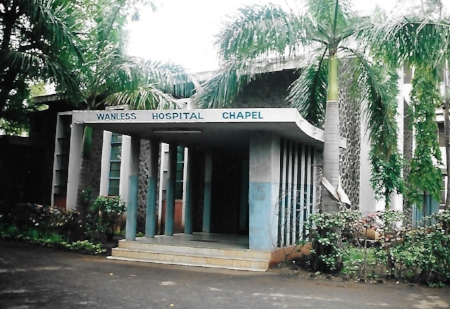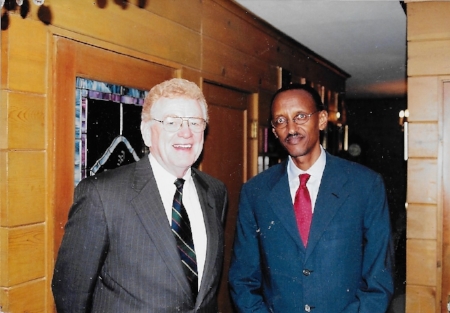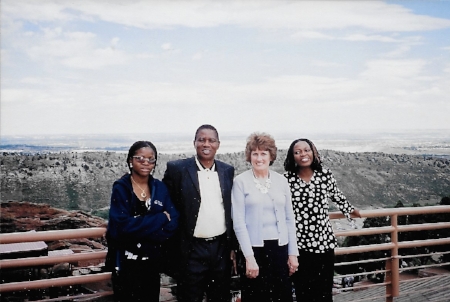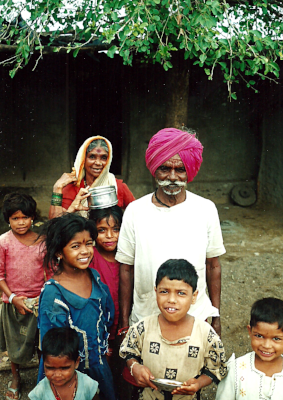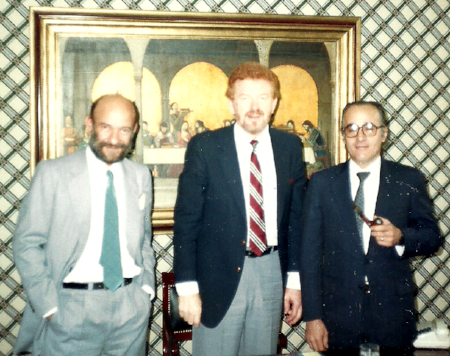Dr. Noah was a very effective administrator, as well as a skilled surgeon. The hospital was a 210-bed facility. The Nazarenes had previously handed over the organization to be managed by indigenous leaders but stayed in the relationship to donate about 7% of the hospital’s overhead. The hospital was doing a remarkable job of reaching out and serving a catchment area of over a quarter million people.
The missionary guest house, where I would stay, had been built in 1906. It was quite a stately old manor house with high ceilings and large rooms.
We started the hospital needs assessment study almost as soon as we drove into Washim. The rain came in wind-driven cloud bursts, but the people all smiled and cheered on the moisture.
The Reynolds Memorial Hospital had, over the years, been frequented by Nazarene denominational work groups and medical teams. It also had enjoyed some kind of relationship between the nurse-training schools of the US Nazarene universities and the hospital in Washim. In fact, there was one nurse intern, Meredith Carroll from Point Loma University, also at the guest house with another team to follow a few days later.
Thursday, June 17
Thursday was set aside to visit the countryside surrounding Washim and observe the hospital’s medical work that had been established in the rural villages. In 1987, Reynolds Memorial Hospital and the Nurses Training School had reached out to ten villages, then to 36 in 1993, and 111 in 1998. By 2001 they were taking their “community-based health project” to 145 villages and reaching over 200,000 people in the rural communities.
Their program became very successful in meeting the needs of preventive, as well as curative, medical service and included areas of: (l) immunization, (2) under-five (years of age) clinics, (3) nutritional rehabilitation, (4) antenatal clinics, (5) HIV/AIDS testing and (6) mobile clinics.
One of the villages that I visited on Thursday was home to 1,500 people. Many women and children had gathered into a make-shift clinic. When I entered, one of the Reynolds Hospital nurses was teaching nutrition to the group with the help of charts, pictures, and other visual displays. When that was completed the mothers and children all lined up for their monthly checkup exams. Then when finished they sang some simple songs, had a scripture reading, and prayed.
Dr. Noah told me that when they first started in the villages the kids and mothers would all run away. Now they eagerly awaited the team of about seven nurses and students.
He also related to me how the hospital had embarked upon a very ambitious plan whereby they were endeavoring to immunize every child and mother in all 145 villages in a three-month period of time. No one in the government health offices thought the plan to be possible but they were happy to supply the medicines anyhow.
Somehow Dr. Noah’s team was able to accomplish 100% of their goal within the three-month period. “We even chased some women and children down in the fields to give them their shots,” he told me. To their knowledge there had never been a program to accomplish such a feat, either in India or the United States.
At 3 p.m. on Thursday, I was scheduled to meet at the hospital board room with Dr. Noah’s entire hospital and school team. Their excitement and commitment was contagious. They were eager to tell me all about their future goals and plans. They had become a very successful unit. The two hours I spent with them flew by quickly.
Upon leaving the team meeting, where I was given lists of prioritized department needs, we stopped for a cup of good Indian chai (tea). Dr. Noah decided to contact Dr. Bidari in Miraj, India, on his cell phone and make sure my airplane tickets from Bombay to Kolhapur had been left off at the Avion Hotel in Bombay. Anna Marie had carefully instructed Dr. Bidari that the connection tickets needed to be at the Avion Hotel so that I could continue on my trip to his hospital in Miraj. Dr. Bidari’s assistant had not a foggy idea of what Dr. Noah was even talking about. It was looking like Dr. Bidari had completely spaced out his need to get my ticket purchased and delivered. Dr. Noah was upset because he had just talked to Dr. Bidari the week before and was assured that everything was “being well taken care of.”
Eventually, Dr. Noah got Dr. Bidari on the phone and he was very unsure of things in his responses. Finally, I had Dr. Noah put me on the line.
“Hello, Dr. Bidari,” I greeted him cheerfully. “I understand we have had some miscommunication. I just need to tell you that I’m sure you have everything under control. However, if those flight tickets are not at the Avion Hotel when I arrive in Bombay late Friday night, I know I will not have time to go and purchase the tickets needed for the 6 a.m. flight on to Kolhapur. So, I would then have to go ahead and board a flight directly back to the US and not visit your hospital in Kolhapur.”
Dr. Bidari assured me that everything would “be well taken care of.”
I tried to contact Anna Marie in Colorado by e-mail but was never able to make any connection with AOL in the US.
Thursday evening, Dr. Noah invited me to have dinner with his family in their home on the compound.
Friday, June 18
I had become accustomed to having some institution official in some foreign country just suddenly inform me that I would be speaking to some large group of people gathered in some building somewhere.
Friday morning I was delegated and informed that I would be speaking for 30 minutes at the campus church building for the hospital staff and Nurses Training College’s weekly chapel service. I swallowed twice and commenced to speak. It turned out to be a good time together; God really blessed the session.
We had been able to accomplish a lot at the Reynolds Hospital in a very short period of time. I was very impressed with Dr. Noah and his team in Washim, India. They were certainly proving that the quality, efficiency, and community impact of a missionary hospital need not diminish when the sacred missionaries with all the answers went back home. My guess was the hospital was in better shape than it had been during the ten previous years when they were still there. Of course, that was just one humble man’s opinion.
One feature of the Reynolds Hospital that greatly impressed me was the fact that they had effectively operated their own blood bank with full storage and investigative facilities for HIV/AIDS, as well as hepatitis A, B and C.
As you have read my previous journal entries, you have become aware of my deep concern for the growing HIV/AIDS epidemic around the world. It would frighten me when I visited any part of Africa, India, China, Vietnam, Thailand, and even Russia, to realize that hardly anyone in the world had truly grasped the magnitude of the rampant killer disease. Everyone still seemed to be in denial of the fact that over 40 million people in the world were proven carriers of the disease and that over five million more were proven to have contracted the disease for the first time in just the last year.
No one seemed to think that it would affect them. And even if they did, they assumed there would be a magic cure developed by the American doctors to take care of them.
But the ugly truth had passed up fiction a long time back. There was no cure presently, nor was there even one on the horizon. But, the world had quickly and silently entered into the dying stage of the disease around the world.
Next Week: Can we make it to the Wanless Hospital in Miraj?





